Home
Health campus
Location and history
The site is located within the town centre of Weybridge. It is in close proximity to a number of Pharmacy, shops and community facilities.
The below map demonstrates the main roads and their relation to the site for both private cars and public transport. The site is well connected to the main road network.
The main vehicle access to the site is via a private road off Church Street which leads to the site’s current central parking area. The secondary access from Minorca
Road was purely there for emergency services access and controlled by a barrier. This entrance also allowed access to 12 car parking spaces that were used by the two GP Practices.
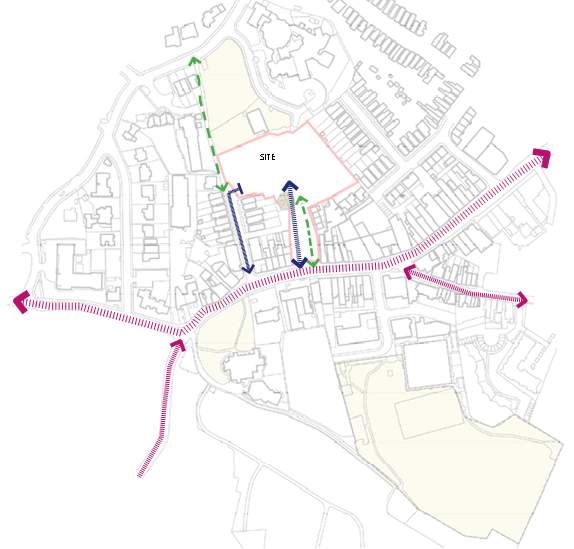
EXISTING SITE, LOCAL CONTEXT
Identified in red on the below diagram, the 0.85 hectare site is located adjacent to, and partially in, the Weybridge Town Centre Conservation Area.
The proposed site layouts included in this document will address the key townscape views within the conservation area.
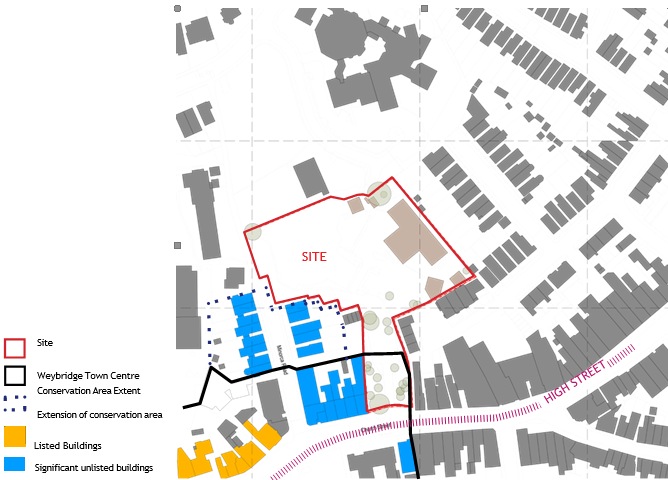
HISTORY - 1928
Weybridge Cottage Hospital
The site has provided a hospital facility for the comunity of Weybridge for over 90 years.
A hospital was first built on the site in 1928 and replaced Weybridge Cottage Hospital on Balfour Road, which had been built in 1889. The Balfour Road site was subsequently converted to office use.
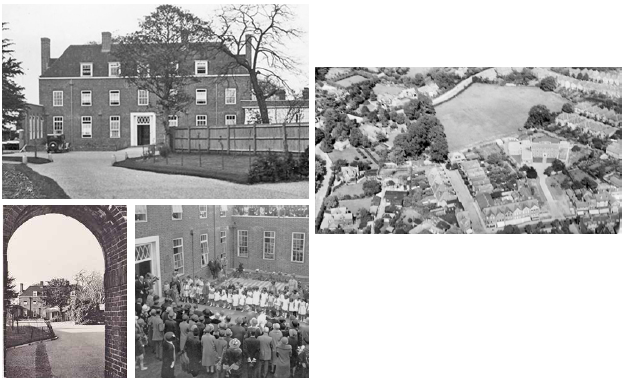
HISTORY - 1962
New Wing constructed
In the early 1960s the hospital was extended and a new wing was opened in 1962.
Over time the buildings were adapted to provide additional health services including GP services, outpatient requirements and additional bedded hospital wards.
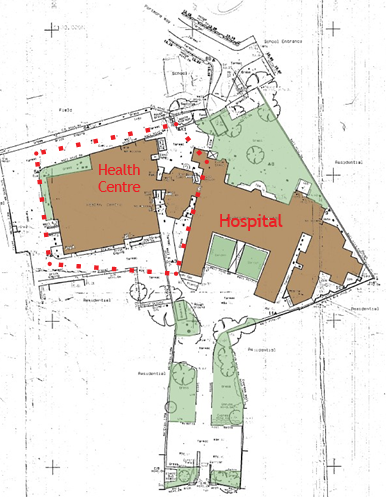
HISTORY - 1999
Community Hospital / Primary Care Centre
By the 1990s the original hospital could not keep pace with the increasing demand for healthcare services in the area and the aging building was in need of costly remedial works.
In 1998 construction of a new-build community hospital and primary care centre began, with priority given to the three wards located on the ground floor and allowing the two GP practices to be located on the first floor. The new location of the community hospital along a phased build programme allowed the old facility to continue operating and to maintain continuity of care.
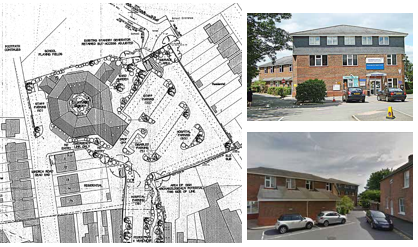
Check out the following documents
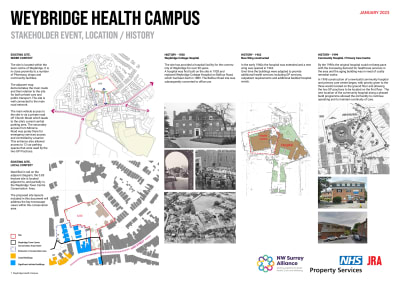
Former health centre
MASTERPLAN - PREVIOUS HEALTH CENTRE
The community hospital was destroyed by fire in July 2017. As a result, two of the GP surgeries were initially moved to Walton Hospital and Walk-In Services were continued St Peters, Woking and Ashford Hospitals.
Once the site was cleared, the NHS established temporary buildings as part of an interim solution for the loss of the facilities. This allowed two of the GP practices to move back to the original site. This temporary accommodation comprises 20 interlinked pre-fabricated buildings and incorporates a number of treatment rooms alongside the GP practices.
The NHS are keen to provide a permanent facility to offer a wider range of healthcare services for the public and to improve the environment and working conditions for staff.
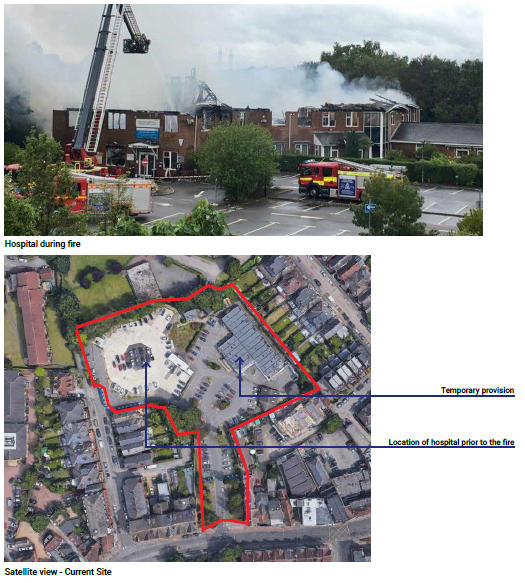
Masterplan - Previous Health Centre
The previous centre was a 3-storey pitched-roof block, primarily brick-clad, located to the north-west corner of the site, with the remainder of the site used for parking.
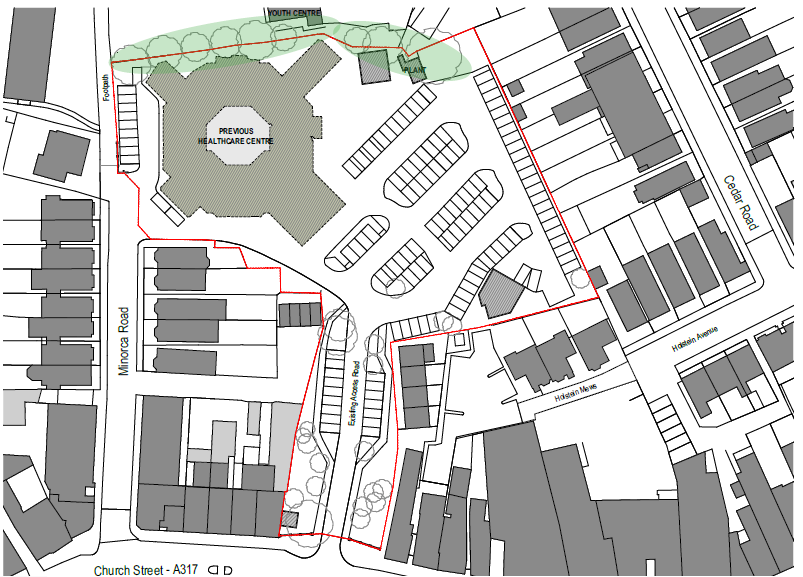
Masterplan - Current Arrangement
The temporary health centre sits along the east boundary of the site alongside the resources centre, workshop and substation that remain from the previous layout.
The rest of the site was cleared of the hospital ruins following the fire, and is currently used as parking by the centre’s staff and visitors.

Masterplan, context and phasing
CONTEXT / CONSERVATION AREA
Whilst the main area of the site is not located within the Weybridge Town Centre Conservation Area, there is a need to for the design to be consistent with the local vernacular - however the design should not be a pastiche.
There should be a strong external design which brings together the local aesthetic and NHS principles.

LOCAL VERNACULAR
Some notable buildings in close proximity to the site along Church Street.

PHASING
As part of the design strategy for the site it was important for the NHS that there would be a level of continuity in terms of provision of health services, specifically in terms of retaining the GP Practices on-site, whilst the new health centre is under construction. Phasing was an important consideration in developing the indicative layouts.
Phase 0 - Existing
Temporary Health Centre currently operating on the site. Remainder of site utilised as a car park.

Phase 1 - Construction Stage 1
Temporary Hospital to remain in use with access maintained and partial car parking.
West side of site to be used for new Health Centre.
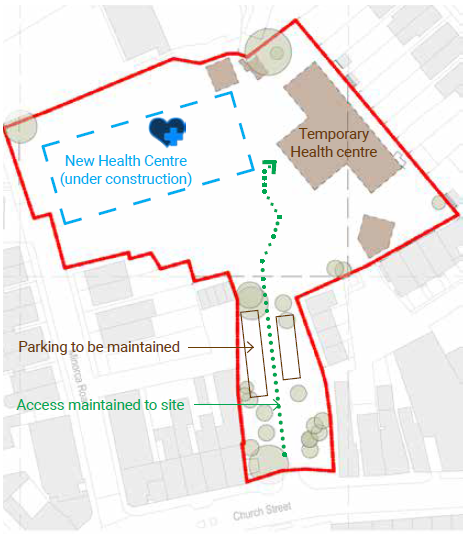
Phase 2 - Construction Stage 2
Once new Health Centre is complete and operational, temporary centre to be removed to allow additional car and cycle parking to be reinstated.
Parking to be provided for the Health Centre and residential units.
Two access points to the site reinstated.
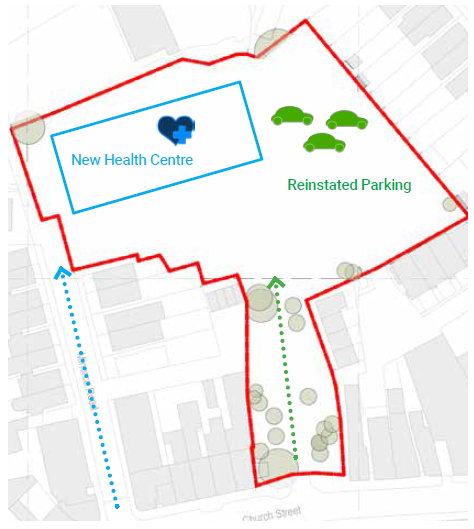
Design parameters
SUSTAINABILITY / NHS
NHSPS are committed to Sustainability as set out in the NHSPS Green Plan. One of the main aims of the Green Plan is to work towards reaching net-zero carbon by 2040 and part of this will be to move away from fossil fuels as a heating source.
In addition to an energy efficient design we are also looking at Adaptation-led systems to deal with, for example, higher temperatures and higher precipitation, due to climate change, and to maximise Biodiversity to encourage a mix flora and fauna on our sites to improve the local environment and air quality.
The NHS Property Services Green Plan outlines how they will improve in the following areas:
- Increased resilience of the NHSPS estate to manage climate change
- More resources to channel into patient care
- Better use of our data for estate management
- Improved workforce engagement on climate change
- Assurance for stakeholders creating confidence in our environmental stewardship
- Greater customer satisfaction
- Reduction in our environmental impact
- Conserving, protecting and enhancing our estate biodiversity
- Reaching overall NHSPS sustainability goals
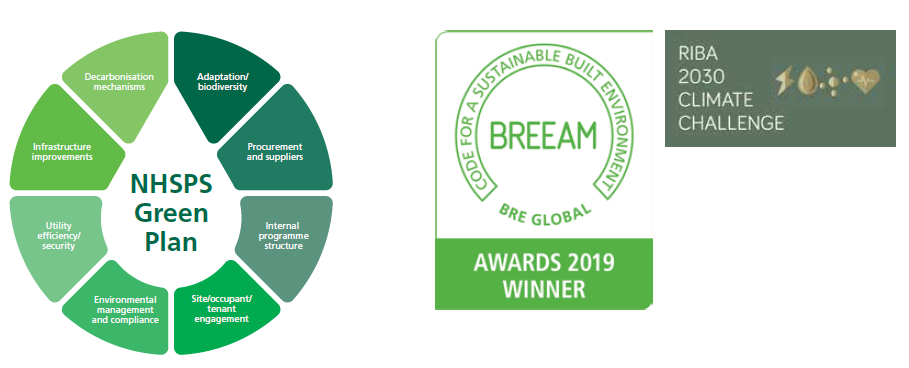
SUSTAINABILITY / JRA
At JRA, sustainability has been part of our DNA for the last 20+ years.
Our projects provide a considered response to the serious issues of climate change and global warming and to modern occupier’s environmental aspirations and expectations. JRA’s commitment to sustainable architecture is reflected in the practice being awarded the British Research Establishment’s ‘BREEAM Professional Champion Award 2019’ and having been shortlisted for the last two years for the Architects Journal ‘Sustainability Practice of the year’.
Our approach is underpinned by the increasing need for environmental action and the practice’s commitment to the RIBA’s 2030 Climate Challenge.
We aim for our projects to:
- Create healthy environments for individuals and businesses through a design led approach
- Actively seek out opportunities for making positive contributions to the circular economy through smart material choices and procurement strategies
- Have the potential to be Net Carbon Zero
- Mitigate climate change impacts, wherever possible
We encourage our clients to pursue their own sustainability goals, often through BREEAM certification, and we have been championing this accreditation system across the practice’s projects for over ten years.
WEYBRIDGE / A SENSE OF PLACE
The enclosed case studies indicates buildings from the surrounding area of Weybridge that will form part of the design cues for the detail development of the design for the Health Campus.
The proposal is for a brick building with a colour that is appropriately chosen to reflect the local buildings as set out here.
54 Church Street, KT13 8DP
This building is deemed to bring together all of the key characteristics of Weybridge, and is therefore seen as a strong reference to the design language within the health campus.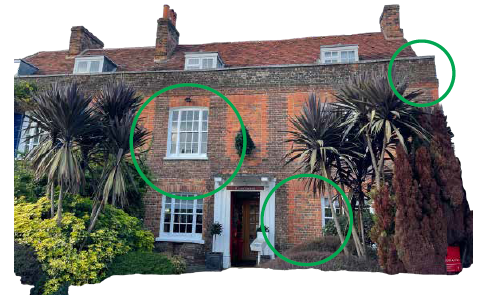
- Thee windows are set back from the façade and there is a wide windowsill to the bottom of the window to provide structure and weight to the window.
- The second story windows are larger than the ground floor windows
- The lintel over the window is brick but has two different stacked layers.
The parapet is of importance with the stream course helping to articulate the facade.
28 Church Street, KT13 8DP
The present version of the Weybridge Hall was built in 1920 (during the same period as the original Weybridge Hospital) as a cinema for the locality. It is situated at the entrance of Weybridge and given the façade, reflected the aspiration and status of the town.

- The windows provide a sense of scale to the building as they are set back and of different sizes.
- The bay windows provide a further point of interest.
- The the brick stream provides further interest and detailing.
- There are three courses of brick detailing within the façade, which again breaks up flat planes, providing the illusion of varying depth.
1C Church Street, KT13 8DA
This complex of shops and flats (including Lloyds Bank) was built during the 1990’s. Whilst some of the character of central Weybridge is retained i.e. the use of the colour of the bricks, the design lacks any interest and with its flat façade, the building creates a sense of limited dimensional massing, even though it is only two stories.
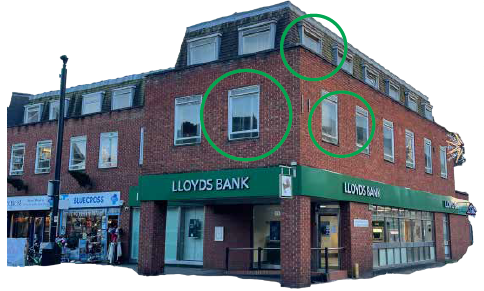
- The Lloyds complex utilises the same red brick as those used within Weybridge Hall
- The design plays with the concept of a parapet, however there is little detailing to distinguish it from the rest of the wall line
- The windows within the Lloyds complex are flush with the rest of the façade. Whilst this building is smaller than Weybridge Hall it feels as though there is a greater sense of mass because of the lack of interest.
25-27 High Street Church Street, KT13 8DX
The main parade of shops was built during the 1920s as part of the expansion of the train and underground lines in London. As such it follows closely many of the design cues from similar pa- rades across London during this period. The design replicated the parapet feature found in 54 Church Street, however there is a lot emphasis on break up the mass.

- This parade is the largest single building within the greater Weybridge area
- A number of elements are used to create detail e.g:
- the edging of the brick line
- the air bricks
- the brick line around the window
- the cut line of bricks below the window
- the fan above the window and the stone line above that.
Masterplan/Proposed massing
PROPOSED MASTERPLAN
Following feasibility studies on potential re-use schemes for the site, the proposed layout is as enclosed plans.
Proposed Arrangement 1
The new health centre is to be located to the north-west, similarly to the previous centre, with the new parking layout located in the east part of the site.
The remainder of the site is to be used for landscaping and parking.
- 117 Car parking spaces
- 12 Car parking spaces near the Urgent care entrance
- MRI unit platform
Proposed Arrangement 2
In this option the proposed parking layout works with the rotation of the Health centre and the existing access road which sits at an angle.
- 117 Car parking spaces
- 12 Car parking spaces near the Urgent care entrance
- MRI unit platform
Both parking layout options allows for a landscape scheme to work with the parking with pockets for planting of trees and other greenery.

INDICATIVE MASSING
The proposed footprint allows the east wing to sit slightly further back towards the rear site boundary, retaining the same low block massing and sympathetic relationship to the site surroundings. The trees on the adjacent site forms a natural backdrop.

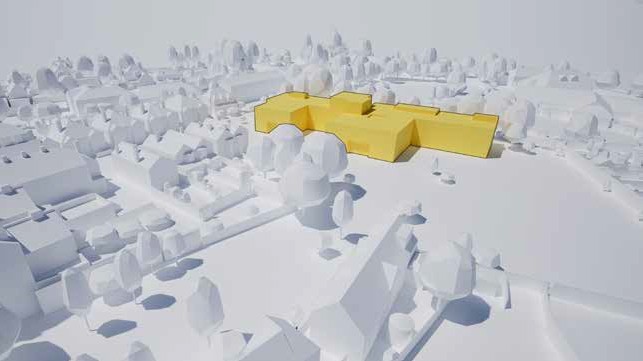
Service requirement / use diagrams
SERVICE REQUIREMENTS
Primary and community healthcare services will be delivered from the new Weybridge Health Campus, including Primary Care Network local services.
Church Street Practice has a current list size of approximately 14,300, whilst Rowan Tree Practice has a current list size of approximately 15,500.
In designing the building significant thought has been given to manage increasing future demand, in terms of space allocation, internal design and clinical and patient environment.
A future combined primary care population of 29,800.
The creation of Integrated Care Systems, presents an opportunity for primary care, acute, secondary, mental health, social care and other services to come together and work across a system that is designed around population health need, supplemented by Local Authority services as appropriate.
Future service models will provide integrated local services that support multi- disciplinary working and share facilities to improve access. The Weybridge facility needs to be flexible, adaptable and capable of accommodating the challenge of future service changes at minimal expense. The facility will have demise, bookable and flexible rooms and floorspace to achieve occupancy rates as close to 85% as possible during opening hours, which in the future will be based on extended hours.
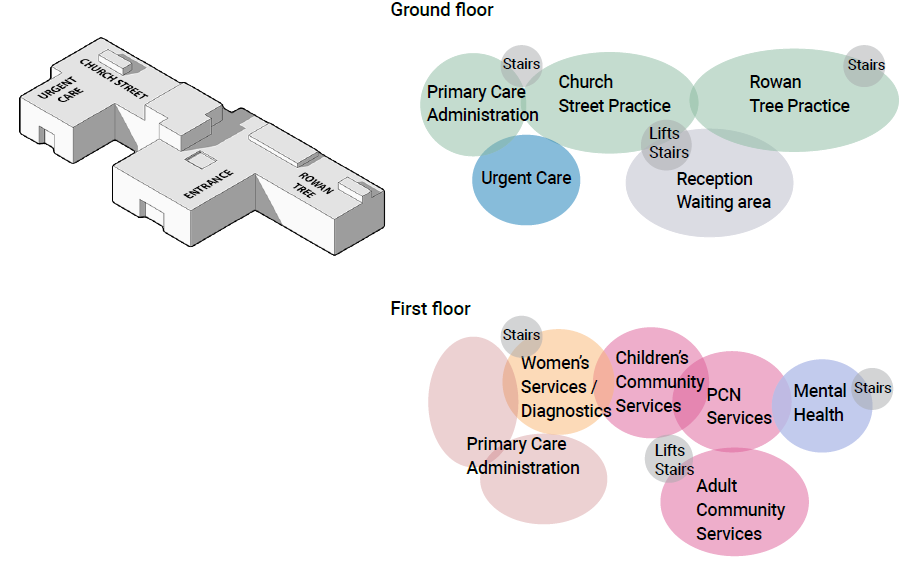
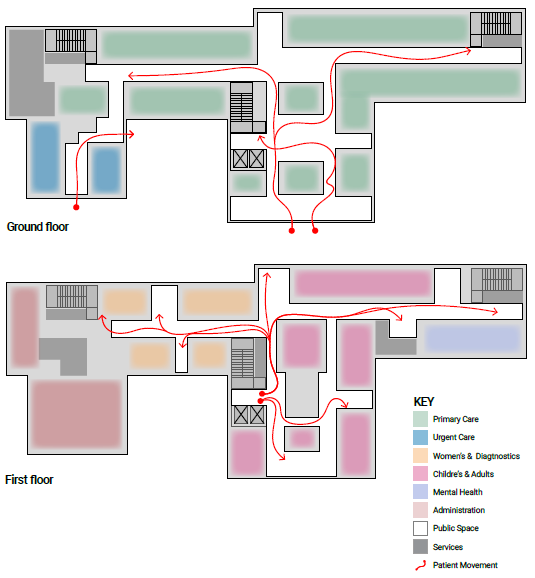
Design development - sketch views
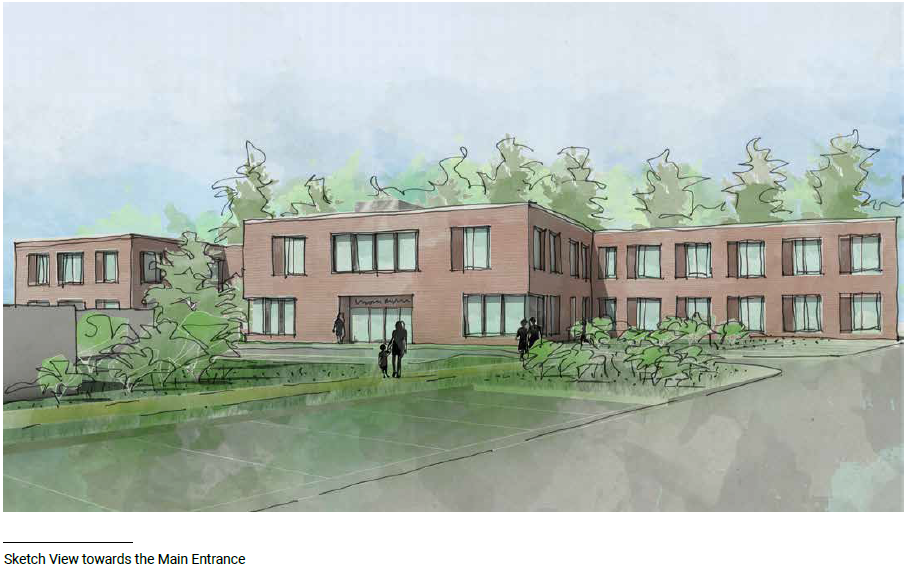

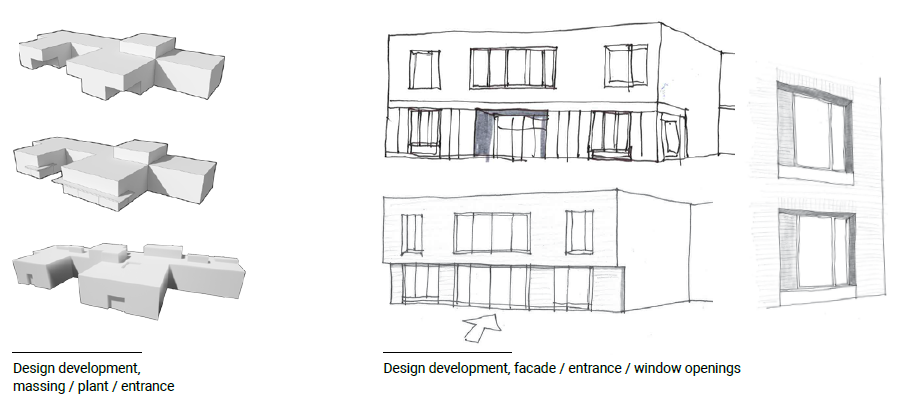
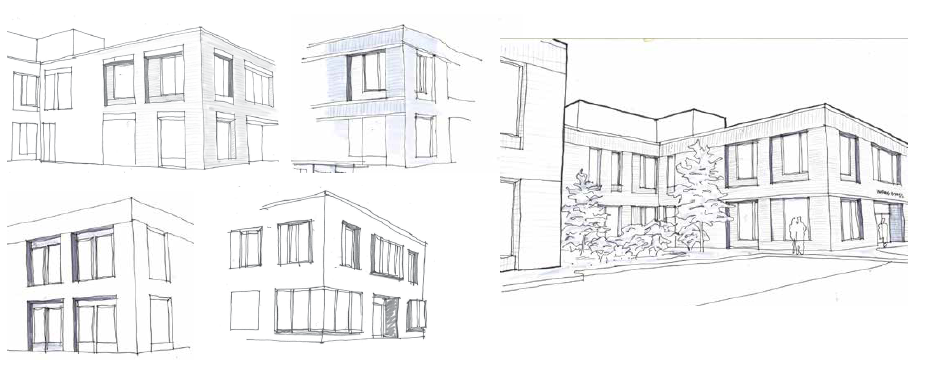
This engagement phase has finished

...

